对于U型管地下换热器基于光纤温度计的改进热响应测试
- 格式:pdf
- 大小:1.39 MB
- 文档页数:8


总756期第二十二期2021年8月河南科技Journal of Henan Science and Technology垂直U型地埋管换热器性能的动态仿真代兰花肖瑶瑶(常州工学院,江苏常州213032)摘要:本文基于圆柱内热源理论建立了垂直U型地埋管换热器的数学模型。
在MATLAB软件中建立了垂直U型地埋管换热器的动态仿真平台。
利用该仿真平台研究进口温度、进口流速、钻井深度、回填材料、土壤以及间歇运行时间比等因素对垂直U型地埋管换热器换热性能的影响规律。
结果表明,在一定范围内提高进口温度可以提升垂直U型地埋管换热器的换热性能;当进口流速为0.4~0.6m/s时,增大进口流速可以有效提升垂直U型地埋管换热器的换热量;钻井深度越深,钻孔总换热量增加明显,单位钻孔深度换热量略微减小;但随着运行时间的增加,回填材料导热系数对换热的影响逐渐降低;土壤的导热系数越大,垂直U型地埋管换热器的换热量越大;采用间歇运行的方式可以提升垂直U型地埋管换热器的换热性能。
关键词:垂直U型地埋管换热器;动态仿真;影响因素;换热性能中图分类号:TU831.4文献标识码:A文章编号:1003-5168(2021)22-0104-06 Dynamic Simulation on the Performance of Vertical U-Shaped Buried PipeHeat ExchangerDAI Lanhua XIAO Yaoyao(Changzhou Institute of Technology,Changzhou Jiangsu213032)Abstract:In this paper,a mathematical model of the vertical U-shaped borehole heat exchanger is established based on the theory of the heat source inside the cylinder.The dynamic simulation platform of the vertical U-shaped buried pipe heat exchanger is established in MATLAB software.The simulation platform is used to study the influence of fac⁃tors such as inlet temperature,inlet flow rate,drilling depth,backfill material,soil,and intermittent operation time ra⁃tio on the heat transfer performance of the vertical U-shaped buried heat exchanger.The results show that increasing the inlet temperature within a certain range can improve the heat transfer performance of the vertical U-shaped bore⁃hole heat exchanger;when the inlet flow velocity is0.4~0.6m/s,increasing the inlet flow velocity can effectively in⁃crease the heat transfer of the vertical U-shaped borehole heat exchanger;the deeper the drilling depth,the increase in the total heat transfer of the borehole is obvious,and the heat transfer per unit depth of the borehole slightly de⁃creases;however,as the operating time increases,the thermal conductivity of the backfill material gradually reduces its impact on heat transfer;the greater the thermal conductivity of the soil,the greater the heat transfer of the vertical U-shaped buried heat exchanger;the use of intermittent operation can improve the heat exchange performance of the vertical U-shaped borehole heat exchanger.Keywords:vertical U-shaped boried pipe heat exchange;dynamic simulation;influencing factors;heat transfer per⁃formance地源热泵技术的重点是设计出高效的地埋管换热器,地埋管换热器直接影响了整个系统的效率。

U型埋管地热换热器地传热模型及换热性能地提高摘要高效利用可再生清洁地地热能、提高人居环境地舒适度并实现节能环保是本课题研究地主要目地 . 传统地空调系统受环境温度影响大、能效较低。
水源热泵空调系统存在回灌难、污染地下水等问题。
土壤源热泵空调系统在供暖、制冷、供热水等方面具有运行稳定、效果良好等优点 , 在国外己广泛应用 . 但国内地研究与应用起步较晚 , 解决地埋管换热器与土壤间地强化传热、系统初投资较高等问题是推动其发展地关键 . b5E2RGbCAP本文以竖直U型埋管换热器为研究对象,采用数值模拟方法对影响地埋管换热效率地各种因素进行研究 , 结果表明 , 井深、流体速度、回填材料导热系数及支管中心距对换热地影响较为明显,当井深小于150m时,增加井深使换热器地总换热量增大,但当井深大于250m时,由于支管间热短路现象加剧,随着井深地增加总换热量趋于平缓,且钻井费用提高,因此最佳井深范围可取 150m-250m提高 u 型管内流体地流速 , 使总换热量与 u 型埋管换热器效率增加 , 当流速超过 0.8m/s 时两者地增加速率都已很低 , 而同时 u 型管进出口压降却迅速增大 , 因此, 推荐 u 型管内经济流速范围为 0.4m/s-0.8m/s. p1EanqFDPw关键词地源热泵;换热器;传热模型;换热器效率引言随着传统不可再生能源地不断消耗 , 能源紧缺地问题日益严重 , 具有节能特点地地源热泵(ground source heat pump> 系统越来越受到人们地关注 . 地源热泵系统是一种利用地下浅层地温地热资源 <常温土壤或地下水)地既可供热又可制冷地高效节能热泵系统 . 它卞要包括三个部分 :从土壤、地下水或地表水吸热 / 放热地装置;热泵机组;送风系统 . DXDiTa9E3d 根据地源热泵祸合换热系统地换热方式 , 可以把地源热泵系统分为闭式循环系统和开式循环系统 . 本文研究地是闭式循环垂直式热泵系统 . 设置地热换热器是闭环地源热泵(或称地下偶合热泵)空调系统地最大特点 . 这种地热换热器中地传热是管内流体与周围岩土之间地换热 , 与两种流体之间换热地常规换热器有很大地不同 . 通常地热换热器有水平和竖直两种布置方式 . 竖直布置地地热换热器通常都是在钻孔内布置 U 型地塑料管 ,再加上回填材料 , 与周围岩土构成一个整体 . 由于竖直埋管地热换热器具有占地少、工作性能稳定等优点 ,己成为工程应用中地主导形式 . 对其传热模型地研究也就成为开发地源热泵空调系统首要地课题 . 地源热泵空调系统地主要缺点是其地热换热器地初投资较高 ,这也是阻碍地源热泵空调系统发展地主要原因之一 . 因此对地热换热器地结构进行优化设计,并提供可靠地设计计算模型是降低地热换热器造价地重要途径, 也是推广地源热泵地关键技术之一 [1]. RTCrpUDGiT对地源热泵U型管地下换热器地研究,在工程上国内外主要使用线热源模型和柱热源模型[2-3],虽然模型考虑了 U型管地具体形状以及其他影响因素,但由于使用地都是一维模型 , 只研究某水平平面 , 不能全面反映整个换热区域地换热情况[4-5]. 刁乃仁等通过解读地方法得出了一维和准二维地模型 [6].. 但其一维和二维模型主要是建立在回填土区域 , 由于 U 型管地下换热器传热地不均匀性 , 回填土最外层地壁温显然不是均匀地 . 而且在非稳态过程中 , 回填土最外层壁温很难确定.为了研究整个换热区域地情况,本文使用CFD数值仿真软件对地下 U 型管换热器进行了模拟,进而研究了 U型管换热器主要参数对U型管换热器换热效率地影响 .5PCzVD7HxA1.数学模型1. 1 假设条件由于 U 型竖直埋管地下换热器地几何形状和土壤传热地复杂性 , 为了减少网格数量和降低计算地难度 , 所以要进行必要地简化 . 同时, 为了保持所得结果地精度符合工程要求 , 作如下假设 : jLBHrnAILg<1 )土壤是均匀地 , 而目在整个传热过程中土壤地热物性不变 . 由于地下换热器引起地土壤温度变化比较小 , 因此可以这样假设 . xHAQX74J0X<2 )忽略土壤中水分迁移地影响 .( 3> 忽略 U 型管管壁与回填材料、回填材料与土壤之间地接触热阻 .(4> 忽略地表温度波动以及埋管深度对土壤温度地影响,认为土壤温度均匀一致,初始阶段为当地地年平均气温.LDAYtRyKfE(5> 认为U型管底部弯管是绝热地,而流体地速度分布和方向改变.(6>钻孔间距足够大,忽略孔与孔之间地传热影响.1.2 一维导热模型工程上对单U型埋管与地层地传热问题,通常分为两部分来处理.一是钻孔内部地传热,二是由钻孔壁面至外部地层之间地换热.与钻孔壁以外部分地传热过程相比,由于钻孔内部(包括回灌材料、管壁及传热介质>地几何尺寸和热容量都相对要小得多,而且其温度变化都较为缓慢,因此可将钻孔内部地传热过程当作稳态地传热过程来处理.除了对于讨论地时间尺度小于数小时地动态问题外,这样地简化已被证明是合理地和方便地.另一方面,由于钻孔地深度远大于其直径,因此,岩土和钻孔地回灌材料中地轴向导热,与横截面内地导热相比可以忽略不计.由于U型管地结构特点,钻孔横截面上地导热明显是二维地,求解较为困难. 因此,工程上采用地最简单地模型是把钻孔中U型管地两个支管简化为一个当量地单管[8],由此回避了 U型埋管两支管与钻孔因不同轴而带来地复杂问题,并进而把钻孔内部地导热简化为一维导热.显然,这样地模型缺乏理论依据,过于粗糙, 当然无法讨论U型管两支管地位置及其相互间地传热对整个换热过程地影响.简化地一维模型不能反映管间距和孔外地层地导热系数对孔内热阻地影响.Zzz6ZB2Ltk1.3二维导热模型在忽略轴向导热地条件下,如果U型管地两根支管单位长度地热流分别为q1 和q2,根据线性迭加原理,所讨论地稳态温度场应该是这两个热流作用产生地过余温度场地叠加.这就是钻孔横截面上地二维稳态导热模型[7]. dvzfvkwMI1二维模型地引入,对于钻孔横截面上地导热热阻,包括支管与孔壁间地热阻和两支管间地热阻,给出了定量地解读式,进而可以分析讨论U型管在钻孔中地几何配置对导热地影响.因此,二维模型明显优于一维模型.但是在此二维模型中也没有考虑两支管内流体温度沿深度方向地变化.rqyn14ZNXI1.4准三维导热模型一、二维模型都因为没考虑流体温度沿程地变化,因此不能确定各个横截面上地传热量;而且忽略了U型管由于两支管中流体温度地不同而引起地热流“短路”现象.因此,在二维模型地基础上,流体温度在深度方向地变化必须予以考虑.考虑管内流体温度沿着深度方向上地变化,为保持模型地简明,钻孔内固体部分地轴向导热仍忽略不计.这可称为准三维模型[8]. EmxvxOtOco2.各种因素对换热性能地影响2. 1管腿中心距和竖井直径地影响将U形管地管腿中心距分别设为100mm, 80mm, 60mm其他条件与上述模型一样,计算所得每 M深井地平均热流量为 28.82w/m, 27.43w/m,25.13w/m.由此可见,中心距越小时,热流量越小,这是因为,管腿中心距越小,管腿之间相互影响越大.在热阻一定地情况下,埋管周围温度越高,热流量越大,两管腿之间影响越小,相反,埋管周围温度越低,热流量就越小,两管腿之间影响就越大.U型管周围部分,温度依次降低,也正说明了热流量随管腿中心距地减小而减少.而且管腿中心距由84mm 到60mm热流量下降地程度是1 OOmrSJ 80mnd地 1.65倍,这也正说明:管腿中心距越小,热流量减少地程度越大,反过来说,中心距越大,热流量增大地程度越小.SixE2yXPq5流动压力损失分别为 29.98kpa. 3d.35kpa. 30.78kpa, 由此可见,中心距小时,水流经过 U形弯管时,局部压力损失较大,所以总体压力损失稍大.但是6ewMyirQFL管腿中心距为60mm时,压力损失仅比管腿中心距为100mm时大2.7%,因此管腿中心距对压力损失影响很小,可以忽略不计.kavU42VRUs因此,在竖并允许地范围内,为了保证较大地热流量和较小地压力损失,尽量保持较大地管腿中心距,但是由于管腿中心距越大,增加地热流量就越少,因此,没有必要为保持较大管腿中心距,而增加竖井直径,这样会得不偿失.将竖井地直径分别设为200mm. 250mm. 300mn其他条件与上述模型相似,得到地单位深井热流量分别为 28.82w/m. 29.7w/m, 30.35w/m, 这是因为回填物地热阻小于周围土壤 ,竖井直径加大相当于传热热阻减小 , 所以热流量较大 . 但是由计算结果可知,直径为300mn竖井地热流量仅比200mm竖井地热流量大 5%,可见竖井直径对热流量地影响并不很大 .综上所述 , 工程上应使用适宜打井地经济合理地竖直直径 , 而不要为增大有限地热流量而使用大地竖直直径 , 因为这样做会增大工程造价 , 而其优化传热效果并不明显 .2. 2 回填材料热导率对换热效率地影响当考虑地源热泵地性能时 , 回填材料是非常重要地 , 材料要有一个较大地导热率以增加土壤地传热量 , 但这个导热率如果太大地话 , 系统反而可能产生热短路现象(热短路现象是指 :U 型管两管脚之间存在温差 , 温差最大处位于 U 型管进出口处,越往下,温差呈递减趋势,由于U型管进出口处温差大,加之两管间距离较小, 在这里可能发生较强地热量传递 , 从而使出水温度在进口段较短距离内下降(上升>很大, 以致影响传热 . y6v3ALoS892. 3 钻孔深度对换热效率地影响除进水管进水水温取 40C、支管间距取为150mm钻孔深度改变以外,主要参数同表2.通过CFD莫拟计算,结果见图1和图2.从图1和图2可以看出,在钻孔深度增加时,出水口出水平均温度几乎是线性下降,但当钻孔深度超过80m后, 两支管地温升比急剧增加,从80m地 2急剧增加到100m地3,支管间地漏热加剧从而降低了单位管长地换热效率 . 因此, 建议钻孔深度不要太深 , 对要求较低出水温度地工况可以使用两个 U型管并联工作来减少支管间地温升比,提高单位管长地换热效率 .M2ub6vSTnP30^0 SO1090 10钻孔深度/m图1出水温度随钻孔深度地变化曲线Fig.5 Change of the outlet water temperature with holedepth OYujCfmUCwand outlet temperatures2.4不同流速对热效率地影响 根据工程经验,管内流速一般都小于1.2m/s,拟选取1.2m/s,0.9m/s,0.6m/s,0.5m/s,0.4m/s,0.3m/s,0.2m/s,0.15m/s. 流速为 1.2m/s 时,管内流动雷诺数为20000,0.12m/s 时,雷诺数为2000,这样地选取覆盖了从过 渡流到旺盛紊流地不同流态,其单位井深平均热流量变化情况如图7. sQsAEJkW5T由图3可知,在进口水温一定时,传热量随流速增大而增加,但是变化趋势逐 渐变缓•流速在0.12-0.4m/s 地阶段,换热量随流速地增加幅度较大 ,而0.4- 31 iH图2两支管地温升比随钻孔深度地变化曲线Fig.6 Change of the specific value between inlet with hole depth euts8ZQVRd0.6m/s地阶段,换热量随流速地增长幅度较小,约为原来地一半甚至更小,流速在0.6m/s以上时,换热量随流速地增加改变地幅度已经很小,也就是说,每增加单位流速得到地热流量增量随着流速地增加在减小.GMsIasNXkA图3不同流速下热流量地变化趋势3.结论(1>地源热泵U型管地下换热器地换热效率随支管间距地增大而增加,但当支管间距增加到一定值后支管问距地增加对 U型管地下换热器换热效率地影响变弱. 在使用地回填土材料热导率变大时,支管间距地变化对U型管地下换热器换热效率影响变大,因此建议在使用高热导率材料地同时应该适当加大U型管两支管地间距.TlrRGchYzg<2 )地源热泵U型管地下换热器地换热效率随回填土材料热导率地增加而增大•为了提高U型管地下换热器效率,应该努力提高回填土层地热导率.7EqZcWLZNX (3)在钻孔深度增加时,出水口出水温度几乎成线性下降;但是当钻孔深度超过80m时,两支管地温升比急剧增加,从80m地2急剧增加100m地3,支管间地热损失加剧,从而降低了单位管长地换热效率•因此,在实际操作中建议钻孔深度不要太深,对要求较低出水温度地工况可以使用两个U型管并联工作来减小支管间地温升比,提高单位管长地换热效率.lzq7IGf02E数减小,如果流动状态由紊流流动变为层流流动 , 则对流换热系数变化就很显著并且由于地下换热埋管是闭环系统 , 水泵扬程只需克服沿程摩擦阻力和局部阻力不考虑提升高度 , 因此, 流速可以适当取高一些 , 以保证管内流体流动处于紊流状态,从而增加对流换热系数 .但是如果流速过高 , 压力损失会很大 , 增大了循环水泵地扬程 , 得不偿失 , 因此 , 我们应综合考虑热流量和压力地损失 . zvpgeqJ1hk4.研究方向及应用前景目前地源热泵系统地应用以每年10%左右地速度递增 , 未来对于该系统地研究将更集中于高效率和低投资方面 . 未来对于地源热泵系统地研究将主要集中在以下几个领域:4.1 地源热泵系统仿真模拟研究通过仿真模拟技术对地源热泵系统能耗、设计、控制等方面进行分析地手段已经成为对于研究地重要方式之一 , 而地下埋管换热器 <ground-loop heat exchanger ) 是地源热泵系统地重要组成部分 , 它地换热情况是研究地重点 , 因此对于地源热泵系统地仿真模拟 , 主要研究方向集中于地下埋管换热器模型地建立和优化 .4.2 地源热泵系统控制策略研究对地源热泵系统而言 , 如何能够更有效地进行长期稳定地制冷或供热是评判该系统优劣地标准 . 建筑物冷热负荷和地下埋管换热器向土壤地排吸热量不均、地下埋管换热器地换热量受地下水渗流影响等问题 , 同时空调系统中多种冷热源地综合利用已越来越普遍 , 因此对于地下埋管换热器系统控制策略研究显得尤为重要 .4.3 地下埋管换热器填料优化研究对于地下埋管换热器孔洞中填料地优化研究有利于提高地下埋管换热器和土壤之间地换热量 , 提高系统地效率 . 4.4 土壤导热率测试技术研究地下埋管换热器地传热过程较为复杂 , 涉及地因素较多 , 因此建立和完善地下传热模型 , 使其具有更好地适应性和计算精度 , 为地下埋管换热器地设计和土壤热物性地测定提供理论基础必将成为研究工作地重点 . 同时, 在系统地施工中 , 如何能够快速有效地通过测试和仿真 ,从而得到土壤物性参数 , 是目前实际工程中所关心主要技术问题之一 .4.5 多种影响因素地考虑和螺旋埋管等不常见换热器地研究现有地下埋管换热器模型以垂直地下埋管换热器地仿真模型居多 , 而对于水平埋管、倾斜埋管以及螺旋埋管地建模研究相对而言有所欠缺. 随着计算机仿真技术地不断发展 , 考虑到管群地影响、土壤冻融地影响、地下水渗流等相关因素地影响, 必然需要对地下埋管换器仿真模型加大研究地投入 . NrpoJac3v1 参考文献[1]曾和义,刁乃仁, 方肇洪.竖直埋管地热换热器钻孔内地传热分析 .太阳能学报 ,2004,25(3> : 3991nowfTG4KI[2]Gu Yian, O ' Neal Dennis L. An analytical solution to transientheat conduction in a composite region with a cylindrical heat source.Trans ASME,1995,117:242 fjnFLDa5Zo[3]柳晓雷, 王德林,方肇洪. 垂直埋管地源热泵地圆柱面传热模型及简化计算山东建筑工程学院学报 ,2001, 16( 1>: 47 tfnNhnE6e5C,Spitler ,J D. A short time step response factor[4] Y avuzturkmodel HbmVN777sLfor vertical ground loop heat exchangers. ASHREAETrans , V7l4jRB8Hs1999, 105( 2>:475[5] Muraya N K ,O ' Neal D L,Heffingt on W M. Thermal interferenceof adjacent legs in a vertical U-tube heat exchanger for a groundcoupled heat pump. ASHREAE Trans,1996,102(2>:1283lcPA59W9[6]刁乃仁,曾和义,方肇洪.竖直U型管地热换热器地准三维传热模型. 热能动力工程 .2003, 18( 4> : 387[7]. Diao N R, Cui P and Fang Z H, The thermal resistance in a borehole ofgeothermal heat exchanger, Proceeding of 1th2International Heat TransferConference,France, 2002.mZkklkzaaP[8]曾和义,方肇洪.U形管地热换热器中介质轴向温度地数学模型山东建筑工程学院学报 ,2002,17(1>:7-11.AVktR43bpw。

U型竖直地埋管换热器热响应模型及其算法研究的开题报告一、选题背景随着全球水资源的日益短缺,大量的海水淡化技术被开发出来。
其中,利用海水源的地埋管换热器技术因其高效、稳定和经济的特点而成为一种重要的海水淡化技术。
U型竖直地埋管换热器是一种比较常见的地埋管换热器,其具有热响应迅速、结构简单、易于制作和维护等优点。
本文旨在研究U型竖直地埋管换热器的热响应模型及其算法,为更好的应用该技术提供理论支持。
二、研究目的本文的研究目的主要有以下几个方面:1. 研究U型竖直地埋管换热器的热响应特性及其机理。
2. 建立U型竖直地埋管换热器的热响应模型。
3. 分析U型竖直地埋管换热器的热响应模型,并提出改进算法。
4. 对比不同算法的优劣,选取最优算法,为实际应用提供理论支持。
三、研究内容1. 研究U型竖直地埋管换热器的热响应特性及其机理通过建立实验模型和模拟模型,研究U型竖直地埋管换热器的热响应特性,分析其机理,并提取关键参数,为建立热响应模型提供依据。
2. 建立U型竖直地埋管换热器的热响应模型通过分析热响应机理及关键参数,建立U型竖直地埋管换热器的热响应模型。
3. 分析U型竖直地埋管换热器的热响应模型,并提出改进算法对建立的U型竖直地埋管换热器的热响应模型进行分析,找出其优缺点,针对缺点提出改进算法,提高热响应模型的精度。
4. 对比不同算法的优劣,选取最优算法将多种算法用于U型竖直地埋管换热器的热响应模型,比较不同算法的优劣,选取最优算法,为实际应用提供理论支持。
四、研究方法1. 实验研究法建立实验模型,通过对实验数据的分析,提取关键参数,为建立热响应模型提供依据。
2. 数值模拟法利用计算机模拟软件,建立U型竖直地埋管换热器的数值模型,通过模拟计算得到热响应模型的参数,为模型建立提供数据支持。
3. 理论分析法通过理论分析,深入了解U型竖直地埋管换热器的热响应机理,为建立热响应模型提供理论依据。
4. 算法分析法将多种算法用于热响应模型建立,比较不同算法的优劣,选取最优算法。

第52卷第6期2021年6月中南大学学报(自然科学版)Journal of Central South University (Science and Technology)V ol.52No.6Jun.2021双U 型地埋管换热器换热性能模拟分析杨培志1,陈嘉鹏1,陈君文2,李明3(1.中南大学能源科学与工程学院,湖南长沙,410083;2.中航长沙设计研究院有限公司,湖南长沙,410014;3.湖南凌天科技有限公司,湖南湘潭,410005)摘要:针对垂直双U 型地埋管换热器,在MATLAB 平台上建立热渗耦合作用下地埋管换热器的三维数值传热模型,并通过岩土热响应试验验证该模型的正确性。
基于建立的三维数值传热模型,分析U 型管内水流速度、回填材料热物性参数、地下水渗流速度及地下水水位对地埋管换热器换热性能的影响。
研究结果表明:当U 型管内水流速度从0.1m/s 增大到0.2m/s 时,可以明显提高地埋管换热器的换热性能;与增大导热系数相比,增大容积比热对提升地埋管换热器换热性能不明显;当地下水渗流速度从0m/a 增大到35m/a 时,地埋管换热器与土壤的换热效果明显;地下水位对地埋管换热器换热性能有较大影响。
关键词:地埋管换热器;三维数值传热模型;地下水渗流;岩土热响应试验中图分类号:TK52文献标志码:A文章编号:1672-7207(2021)06-1733-06Simulation and analysis of heat transfer performance of doubleU-tube ground heat exchangersYANG Peizhi 1,CHEN Jiapeng 1,CHEN Junwen 2,LI Ming 3(1.School of Energy Science and Engineering,Central South University,Changsha 410083,China;2.China Aviation Changsha Design and Research Co.Ltd.,Changsha 410014,China;3.Hunan Linten Science and Technology Co.Ltd.,Xiangtan 410005,China)Abstract:A three-dimensional numerical model of double U-tube ground heat exchangers (GHEs)was presented with heat transfer and groundwater seepage in MATLAB platform,which was verified by rock-soil thermal response test.Based on the established three-dimensional numerical heat transfer model,the influence of flow rate of U-shaped tube,thermophysical properties of grout,seepage flow rate and groundwater level on heat exchange performance of GHEs was analyzed.The results show that when U-tube water flow rate is from 0.1m/s to 0.2m/s,DOI:10.11817/j.issn.1672-7207.2021.06.001收稿日期:2021−01−10;修回日期:2021−03−15基金项目(Foundation item):国家自然科学基金面上资助项目(51276226)(Project(51276226)supported by the National NaturalScience Foundation of China)通信作者:杨培志,博士,副教授,从事制冷与空调技术的开发及应用研究;E-mail:*******************.cn引用格式:杨培志,陈嘉鹏,陈君文,等.双U 型地埋管换热器换热性能模拟分析[J].中南大学学报(自然科学版),2021,52(6):1733−1738.Citation:YANG Peizhi,CHEN Jiapeng,CHEN Junwen,et al.Simulation and analysis of heat transfer performance of double U-tube ground heat exchangers[J].Journal of Central South University(Science and Technology),2021,52(6):1733−1738.第52卷中南大学学报(自然科学版)the heat transfer performance of the buried tube heat exchanger can significantly be improved.Increasing the volume specific heat to enhance the heat transfer performance of buried tube heat exchanger is not obvious compared to increasing the thermal conductivity.When groundwater percolation rate is from0m/a to35m/a,the buried tube heat exchanger with soil′s heat transfer effect is obvious.The depth of the groundwater level on the buried tube heat exchanger has greater impact on the heat transfer performance.Key words:ground heat exchangers;3D numerical model;groundwater seepage;rock-soil thermal response test随着全球能源与环境问题的日益突出,能源的高效利用与环保已经越来越受到人们的重视。

热响应测试实例及问题分析席雪萍;孙振营【摘要】地埋管地源热泵系统开发利用前景广阔,本文尝试采用基于圆柱热源理论的柱模型,在天津市静海县团泊新城,为某竖直地埋管建设项目设计了2组取热和2组排热工况热响应测试试验,为地源热泵系统优化设计与节能运行,提供了必要的数据依据。
同时我们还总结了热响应测试过程中应该注意的问题,为以后工作提供了建议。
%The exploitation and utilization of ground source heat pump systems have good future. This paper designed two heat-extraction and two heat-injection thermal response tests which are based on cylindrical heat source theory for some vertical buried tube building project in Tianjin Tuanbo New City. The tests provide important data for optimal design and energy-saving operation, The test results are accepted by experts, and consistent with parameters of thermal properties in laboratory. At the same time, we summarizes problems which need taking care in thermal response test processes. And it can supply invaluable opinions and suggestions in future work.【期刊名称】《城市地质》【年(卷),期】2011(006)003【总页数】5页(P49-53)【关键词】地源热泵;圆柱热源理论;热响应试验【作者】席雪萍;孙振营【作者单位】天津市地质工程勘察院,天津300191;天津市地质工程勘察院,天津300191【正文语种】中文【中图分类】TK521.2浅层地热能属于清洁、可再生资源。
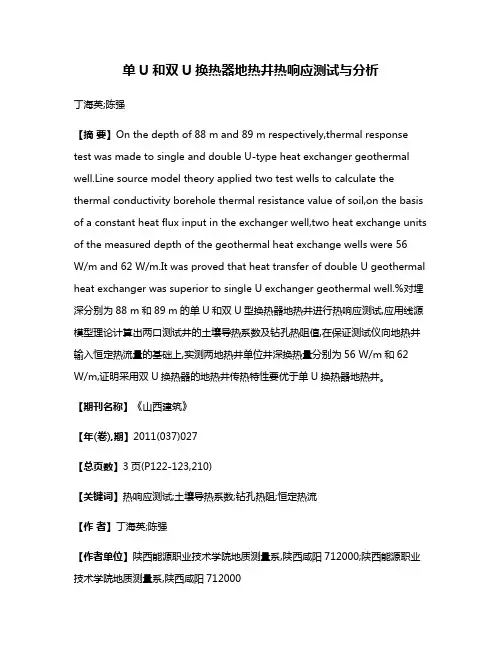
单U和双U换热器地热井热响应测试与分析丁海英;陈强【摘要】On the depth of 88 m and 89 m respectively,thermal response test was made to single and double U-type heat exchanger geothermal well.Line source model theory applied two test wells to calculate the thermal conductivity borehole thermal resistance value of soil,on the basis of a constant heat flux input in the exchanger well,two heat exchange units of the measured depth of the geothermal heat exchange wells were 56W/m and 62 W/m.It was proved that heat transfer of double U geothermal heat exchanger was superior to single U exchanger geothermal well.%对埋深分别为88 m和89 m的单U和双U型换热器地热井进行热响应测试,应用线源模型理论计算出两口测试井的土壤导热系数及钻孔热阻值,在保证测试仪向地热井输入恒定热流量的基础上,实测两地热井单位井深换热量分别为56 W/m和62W/m,证明采用双U换热器的地热井传热特性要优于单U换热器地热井。
【期刊名称】《山西建筑》【年(卷),期】2011(037)027【总页数】3页(P122-123,210)【关键词】热响应测试;土壤导热系数;钻孔热阻;恒定热流【作者】丁海英;陈强【作者单位】陕西能源职业技术学院地质测量系,陕西咸阳712000;陕西能源职业技术学院地质测量系,陕西咸阳712000【正文语种】中文【中图分类】TU831.3采用土壤源热泵制热(制冷)越来越受到重视,此种新能源利用方式既可减少对环境的污染,又可实现较高的能耗比,达到节能减排的目的。
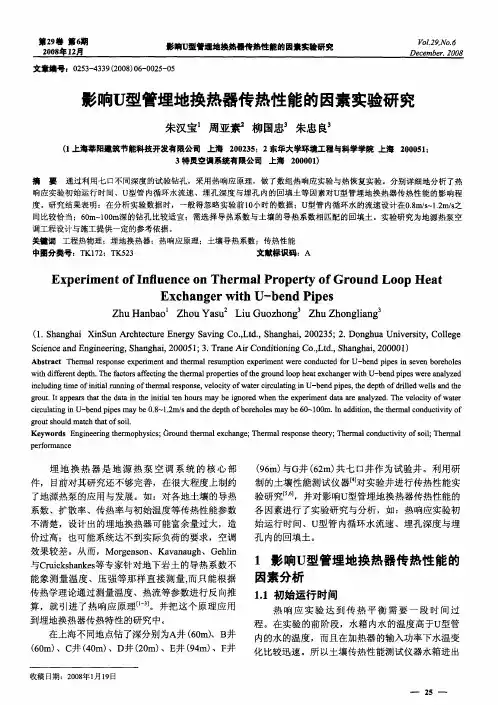
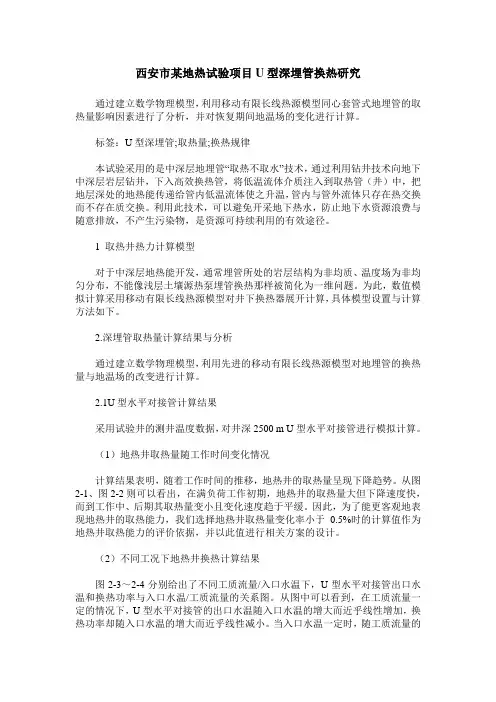
西安市某地热试验项目U型深埋管换热研究通过建立数学物理模型,利用移动有限长线热源模型同心套管式地埋管的取热量影响因素进行了分析,并对恢复期间地温场的变化进行计算。
标签:U型深埋管;取热量;换热规律本试验采用的是中深层地埋管“取热不取水”技术,通过利用钻井技术向地下中深层岩层钻井,下入高效换热管,将低温流体介质注入到取热管(井)中,把地层深处的地热能传递给管内低温流体使之升温,管内与管外流体只存在热交换而不存在质交换。
利用此技术,可以避免开采地下热水,防止地下水资源浪费与随意排放,不产生污染物,是资源可持续利用的有效途径。
1 取热井热力计算模型对于中深层地热能开发,通常埋管所处的岩层结构为非均质、温度场为非均匀分布,不能像浅层土壤源热泵埋管换热那样被简化为一维问题。
为此,数值模拟计算采用移动有限长线热源模型对井下换热器展开计算,具体模型设置与计算方法如下。
2.深埋管取热量计算结果与分析通过建立数学物理模型,利用先进的移动有限长线热源模型对地埋管的换热量与地温场的改变进行计算。
2.1U型水平对接管计算结果采用试验井的测井温度数据,对井深2500 m U型水平对接管进行模拟计算。
(1)地热井取热量随工作时间变化情况计算结果表明,随着工作时间的推移,地热井的取热量呈现下降趋势。
从图2-1、图2-2则可以看出,在满负荷工作初期,地热井的取热量大但下降速度快,而到工作中、后期其取热量变小且变化速度趋于平缓。
因此,为了能更客观地表现地热井的取热能力,我们选择地热井取热量变化率小于0.5%时的计算值作为地热井取热能力的评价依据,并以此值进行相关方案的设计。
(2)不同工况下地热井换热计算结果图2-3~2-4分别给出了不同工质流量/入口水温下,U型水平对接管出口水温和换热功率与入口水温/工质流量的关系图。
从图中可以看到,在工质流量一定的情况下,U型水平对接管的出口水温随入口水温的增大而近乎线性增加,换热功率却随入口水温的增大而近乎线性减小。
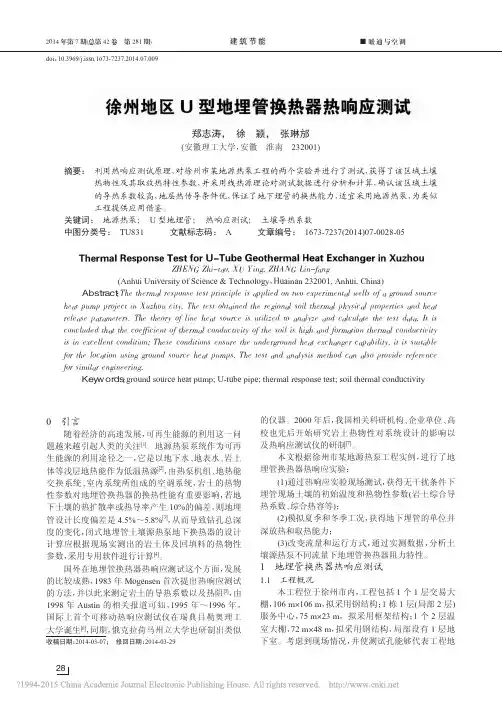
0引言随着经济的高速发展,可再生能源的利用这一问题越来越引起人类的关注[1]。
地源热泵系统作为可再生能源的利用途径之一,它是以地下水、地表水、岩土体等浅层地热能作为低温热源[2],由热泵机组、地热能交换系统、室内系统所组成的空调系统,岩土的热物性参数对地埋管换热器的换热性能有重要影响,若地下土壤的热扩散率或热导率产生10%的偏差,则地埋管设计长度偏差是4.5%~5.8%[3],从而导致钻孔总深度的变化,闭式地埋管土壤源热泵地下换热器的设计计算应根据现场实测出的岩土体及回填料的热物性参数,采用专用软件进行计算[4]。
国外在地埋管换热器热响应测试这个方面,发展的比较成熟,1983年Mogensen 首次提出热响应测试的方法,并以此来测定岩土的导热系数以及热阻[5],由1998年Austin 的相关报道可知,1995年~1996年,国际上首个可移动热响应测试仪在瑞典吕勒奥理工大学诞生[6],同期,俄克拉荷马州立大学也研制出类似的仪器。
2000年后,我国相关科研机构、企业单位、高校也先后开始研究岩土热物性对系统设计的影响以及热响应测试仪的研制[7]。
本文根据徐州市某地源热泵工程实例,进行了地埋管换热器热响应实验:(1)通过热响应实验现场测试,获得无干扰条件下埋管现场土壤的初始温度和热物性参数(岩土综合导热系数、综合热容等);(2)模拟夏季和冬季工况,获得地下埋管的单位井深放热和取热能力;(3)改变流量和运行方式,通过实测数据,分析土壤源热泵不同流量下地埋管换热器阻力特性。
1地埋管换热器热响应测试1.1工程概况本工程位于徐州市内,工程包括1个1层交易大棚,106m ×106m ,拟采用钢结构;1栋1层(局部2层)服务中心,75m ×23m ,拟采用框架结构;1个2层温室大棚,72m ×48m ,拟采用钢结构,局部设有1层地下室。
考虑到现场情况,并使测试孔能够代表工程地收稿日期:2014-03-07;修回日期:2014-03-29徐州地区U型地埋管换热器热响应测试郑志涛,徐颖,张琳邡(安徽理工大学,安徽淮南232001)摘要:利用热响应测试原理,对徐州市某地源热泵工程的两个实验井进行了测试,获得了该区域土壤热物性及其取放热特性参数,并采用线热源理论对测试数据进行分析和计算,确认该区域土壤的导热系数较高,地层热传导条件优,保证了地下埋管的换热能力,适宜采用地源热泵,为类似工程提供应用借鉴。
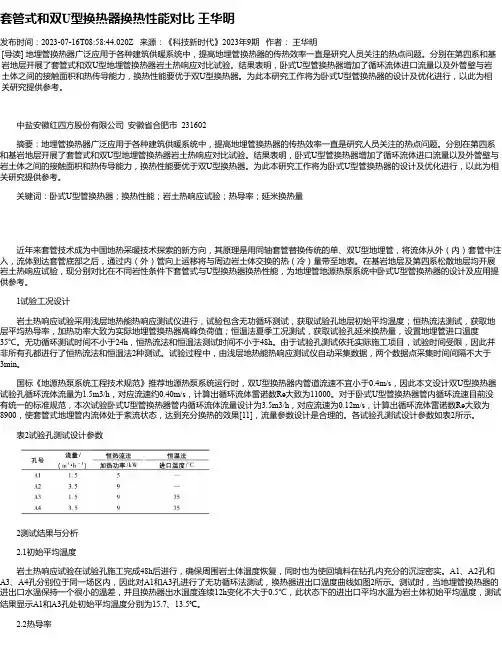
套管式和双U型换热器换热性能对比王华明发布时间:2023-07-16T08:58:44.020Z 来源:《科技新时代》2023年9期作者:王华明[导读] 地埋管换热器广泛应用于各种建筑供暖系统中,提高地埋管换热器的传热效率一直是研究人员关注的热点问题。
分别在第四系和基岩地层开展了套管式和双U型地埋管换热器岩土热响应对比试验。
结果表明,卧式U型管换热器增加了循环流体进口流量以及外管壁与岩土体之间的接触面积和热传导能力,换热性能要优于双U型换热器。
为此本研究工作将为卧式U型管换热器的设计及优化进行,以此为相关研究提供参考。
中盐安徽红四方股份有限公司安徽省合肥市 231602摘要:地埋管换热器广泛应用于各种建筑供暖系统中,提高地埋管换热器的传热效率一直是研究人员关注的热点问题。
分别在第四系和基岩地层开展了套管式和双U型地埋管换热器岩土热响应对比试验。
结果表明,卧式U型管换热器增加了循环流体进口流量以及外管壁与岩土体之间的接触面积和热传导能力,换热性能要优于双U型换热器。
为此本研究工作将为卧式U型管换热器的设计及优化进行,以此为相关研究提供参考。
关键词:卧式U型管换热器;换热性能;岩土热响应试验;热导率;延米换热量近年来套管技术成为中国地热采暖技术探索的新方向,其原理是用同轴套管替换传统的单、双U型地埋管,将流体从外(内)套管中注入,流体到达套管底部之后,通过内(外)管向上运移将与周边岩土体交换的热(冷)量带至地表。
在基岩地层及第四系松散地层均开展岩土热响应试验,现分别对比在不同岩性条件下套管式与U型换热器换热性能,为地埋管地源热泵系统中卧式U型管换热器的设计及应用提供参考。
1试验工况设计岩土热响应试验采用浅层地热能热响应测试仪进行,试验包含无功循环测试,获取试验孔地层初始平均温度;恒热流法测试,获取地层平均热导率,加热功率大致为实际地埋管换热器高峰负荷值;恒温法夏季工况测试,获取试验孔延米换热量,设置地埋管进口温度35℃。
合肥地区U型地埋管换热器热响应测试郭超;马帅;陈龙;汪大海【摘要】对合肥市某地源热泵工程进行热响应测试,通过试验井获取该地区岩土层地质成分、岩土的导热系数以及其它物性参数,进而测定岩土夏季工况排热能力和冬季工况取热能力,为类似工程提供应用借鉴.【期刊名称】《低温建筑技术》【年(卷),期】2016(038)007【总页数】4页(P138-141)【关键词】地源热泵;导热系数;U型地埋管;热响应;排热能力;取热能力【作者】郭超;马帅;陈龙;汪大海【作者单位】安徽理工大学,安徽淮南232001;安徽理工大学,安徽淮南232001;安徽理工大学,安徽淮南232001;安徽理工大学,安徽淮南232001【正文语种】中文【中图分类】TU832.2随着我国经济的快速发展,可再生能源越来越受到人们的关注[1] 。
地源热泵作为一种高效清洁的可再生能源也越来越被人们重视,它是一种利用地下浅层地热资源,既可供热又可制冷的高效节能空调系统。
其重要的换热设备是位于地下的U型地埋管,通过U型地埋管与土壤之间进行能量交换。
土壤的温度、岩土热物性、埋管的形式、间距和深度等因素影响着U型地埋管的换热效率和设计。
比如说岩土的热物性参数,地下土壤的热导率产生10%的偏差,则地埋管设计长度偏差是4.5%~8.5%[2]。
所以,在进行地源热泵系统设置之前的热响应测试具有重要的意义。
国外对地埋管热响应测试的研究比较早,在1983年Mogensen首次提出用热响应测试来测试地源热阻[3]。
我国在2000年以后才开始研究热响应测试对地源热泵系统的影响[4]。
1.1 工程概况本工程位于合肥市内,包括一处员工宿舍两处办公场所。
根据现场的实际情况,选定最能代表地下换热状况的测试区域钻孔。
按照测试现场要求确定2个试验井的位置,见图1,两个试验井埋管参数见表1。
在试验井钻孔过程中,分析岩土层结构为回填材料配置和地埋管施工提供依据。
根据现场采集结果,现场地质主要以粉土为主,少部分夹粉质粘土,打井难度易,造价极低。
U形管地下换热系统的传热数值模拟
马健;张吉炎;郑中援
【期刊名称】《科技信息》
【年(卷),期】2011(000)024
【摘要】土壤源热泵是地源热泵中最常见的应用形式,是高效节能、绿色环保的供暖和制冷方式.其换热器大都采用竖直U形地埋管.据此,我建立了竖直U形地埋管与土壤的三雏传热模型,模拟了U形管内流体的传热、U形管与土壤的传热和土壤的温度场.本文所建的模型考虑了U形管的实际形状,采用GAMBIT为建模软件,FLUENT为计算软件.管内流动状况与实际物理、几何条件完全符合,这与以前研究者将U形管两只管腿等效为柱热源的数学模型相比有质的改进.通过分析这些模拟数据可以得出对土壤源热泵工程设计有指导作用的结果.
【总页数】2页(P340-341)
【作者】马健;张吉炎;郑中援
【作者单位】机械工业第六设计研究院;机械工业第六设计研究院;机械工业第六设计研究院
【正文语种】中文
【相关文献】
1.U形管内流动阻力损失与传热的数值模拟
2.土壤-空气换热系统传热的数值模拟
3.基于Galerkin法的地下粮仓围护结构传热特性数值模拟
4.U型管地下换热系统非稳态传热数值模拟
5.群井地下换热系统初温和构造因素影响传热的研究
因版权原因,仅展示原文概要,查看原文内容请购买。
Geothermics38 (2009) 399–406Contents lists available at ScienceDirectGeothermicsj o u r n a l h o m e p a g e:w w w.e l s e v i e r.c o m/l o c a t e/g e o t h e r m i csAn improved thermal response test for U-tube ground heat exchanger based on opticalfiber thermometersHikari Fujii a,∗,Hiroaki Okubo a,Keita Nishi a,Ryuichi Itoi a,Kunio Ohyama b,Kazuo Shibata ca Department of Earth Resources Engineering,Kyushu University,Motooka744,Nishi-ku,Fukuoka819-0395,Japanb Kyushu Electric Power Co.,Inc.,Takagisehigashi1-10-1,Saga849-0922,Japanc Nisshin Techno Inc.,Yamamoto1063-785,Atsubetsu-cho,Atsubetsu-ku,Sapporo004-0069,Japana r t i c l e i n f oArticle history:Received9July2008 Accepted24June2009 Available online 17 July 2009Keywords:GeothermalThermal conductivityOpticalfiber thermometer GroundwaterflowThermal response testGround heat exchangers a b s t r a c tAs part of a new thermal response test(TRT)and to determine ground thermal conductivities,verti-cal temperature profiles were obtained using retrievable opticalfiber sensors inserted into the U-tubes of two ground heat exchangers(GHEs)installed at Maebaru City(Fukuoka,Kyushu)and Kushiro City (Hokkaido),Japan.Measured profiles and outlet temperatures from TRTs were history-matched with the cylindrical source function.Nonlinear regression was used to estimate the vertical distribution of ground thermal conductivities.The computed distribution is consistent with measured data indicating both the reliability of the opticalfiber thermometer and TRT interpretation.It is expected that TRTs and optical fiber thermometers will prove to be increasingly useful for optimizing the depth of the GHEs installed in heterogeneous formations,and consequently will minimize installation costs of geothermal heat pump systems.© 2009 Elsevier Ltd. All rights reserved.1.IntroductionMore than100ground heat exchangers systems,part of geother-mal or ground-coupled heat pump(GCHP)systems,were installed in Japan in2006and2007,mainly for air-conditioning and for snow melting(Nagano,2008).Most urban areas in Japan are located on alluvial Quaternary deposits,whose complex shallow geology typ-ically is comprised of interbedded units of various lithologies(i.e. clays,silts,sands,gravels)that have different thermal conductiv-ities.Variations in groundwater velocity likely reflect changes in hydraulic conductivities along the lithologic column,and may con-tribute to the differences in the apparent thermal conductivities of the various units penetrated by the ground heat exchanger(GHE). These differences give rise to a vertical variation in heat exchange capacity,potentially a twofold difference,even in the same GHE (Fujii et al.,2006).Since heterogeneous formations are the rule and not the exception,characterization of the thermophysical proper-ties of these formations is clearly an important factor in designing GCHPs.Determining the minimum length of the GHE is essential for the optimal design of the GCHP system and for reducing installa-tion costs.In locations where the ground is heterogeneous,GHEs should preferentially be drilled into lithologic units with high heat∗Corresponding author.Tel.:+81928023343.E-mail address:fujii@mine.kyushu-u.ac.jp(H.Fujii).exchange capacities.For example,if such units occur at shallow depths(yers or subunits within a thick formation),then it is reasonable to infer that heat exchange rates per unit GHE length will be improved by installing shallow GHEs,which will lead to a reduction of total GHE length and possibly lower drilling costs.When applying conventional thermal response tests(TRTs),the optimum design of the GHE is difficult to determine since average thermal conductivity of the GHE is only estimated,whilst conven-tional TRTs incorporate average inlet and outlet water temperature data(Mogensen,1983;Eskilson,1987;Hellström,1991;Sanner et al.,2005).In recent years,work has been undertaken to improve inter-pretation of TRT results.Signorelli et al.(2007)developed a3D finite element numerical model to simulate temperature perfor-mance during TRTs,and to estimate the thermal conductivity of the ing their numerical model,these authors assessed the required duration of TRTs and studied the effect of borehole length,subsurface heterogeneity and groundwater movement on test results.Subsequently,Marcotte and Pasquier(2008)applied Fast Fourier Transform and spline analytical interpolations to line source functions to achieve better prediction of GHE performance, with a correspondingly remarkable reduction in computation time. Their procedure enables several trial and error interpolations in the estimation of formation parameters,even in long-term TRTs.More recently,Bandos et al.(2009)developed a semi-infinite line-source model for accurate modeling of TRTs,which takes into account the effect of surface temperature variations and geothermal gradient0375-6505/$–see front matter© 2009 Elsevier Ltd. All rights reserved. doi:10.1016/j.geothermics.2009.06.002400H.Fujii et al./Geothermics38 (2009) 399–406NomenclatureG cylindrical source functionJ0,J1Bessel functions of thefirst-kindk index of each layerL length of heat exchanger(m)m slope of straight line(◦C/cycle)nstep number of computation time stepsnlayer number of layersntest number of comparisons of measured and calculated T roP r/r oq gc heat exchange rate between formation and heat exchanger(W/m)r radius,radial distance(m)r i inner radius of heat exchanger(m)r o outer radius of heat exchanger(m)t time(s)T ff far-field temperature(◦C)T out outlet temperature of heating medium(◦C)T in inlet temperature of heating medium(◦C)T ro temperature at outer face of U-tube(◦C)T(x)fluid temperature at x(◦C)Y0,Y1Bessel functions of the second-kindZ Fourier numberGreek letters˛weighting factor˛s thermal diffusivity of formation(m2/s)ˇintegral variables thermal conductivity of formation(W/(mK))Subscriptsavg averagecal calculatedEQ equivalentobs measuredin the formation.These authors discussed the appropriate dura-tion of TRTs and provided a new method of averaging borehole temperature.Signorelli et al.(2007),Marcotte and Pasquier(2008)and Bandos et al.(2009)describe the temperature changes in the groundand GHEs during TRTs.However,in many investigations,the actual tem-perature profiles in the GHEs are not measured,and do not always accommodate thermophysical property data of the ground in the analysis of TRT data.The use of opticalfiber thermometers in geothermal wells was first tested in the late1980s(e.g.Sharma et al.,1990).These instruments measure the temperature distribution along an optical fiber sensor,by using the dependence of Raman scattering light’s strength on temperature.The device sends an optical pulse into the opticalfibers,and calculates the temperature from the resul-tant measured reflection.Opticalfiber thermometers measure the temperature along the sensors at short length and time intervals, so their use facilitates collection of information that allows an estimation of the vertical distribution of thermophysical ground properties.Jinguji et al.(2002)developed a thermal conductivity measure-ment method using opticalfiber thermometers and penetrometers as part of an ongoing development of opticalfiber thermometers for evaluating near-surface conditions.According to their method, an opticalfiber sensor and a line heater are inserted into a steel rod,which is driven into the ground before taking measurements.Fig.1.Location of the GHE-1and GHE-2sites at Hokkaido and Fukuoka,respectively. During the time electricity is supplied to the heater,the in-hole temperature is measured with the opticalfiber thermometer,from which the distribution of thermal conductivity is estimated.Fujii et al.(2006)conducted a series of TRTs using opticalfiber thermometers in a50m deep U-tube GHE in Fukuoka City,Japan.To interpret the TRT data these authors developed a computer program that estimated the vertical distribution of thermal conductivity, using a cylindrical source function(Ingersoll et al.,1954)and a non-linear regression technique.The estimated distribution of thermal conductivity showed good agreement with local groundwater and geological information.In their analysis,Fujii et al.(2006)assumed that the temperature of the heating medium in the U-tube of the GHE was uniform during the circulation period,since the temper-ature survey showed the average temperatures of the medium in the up-flow and down-flow branches of the U-tube to be nearly constant at each depth(maximum difference=0.3◦C).Fujii et al.(2006)set the opticalfiber sensors in the backfill mate-rial(silica sand)of the50m deep U-tube GHE.However,this type of sensor setting needs to be refined,since the reading of tempera-ture depends strongly on the distance between the sensor and the U-tube,which is difficult to control underfield conditions.Also,the sensors are not retrievable after the TRTs,which make the testing procedure more expensive to perform.Here,we propose a new TRT procedure that uses retriev-able optical sensors,which is demonstrated in two GHEs:a63m deep GHE in Maebaru City(Fukuoka,Kyushu),and a100m deep GHE in Kushiro City(Hokkaido),in western and northern Japan, respectively(Fig.1).During these tests opticalfiber sensors were positioned in the U-tubes to record the vertical temperature profile in each GHE.To evaluate the TRT results the vertical distribution of temperature in the heating medium during circulation was investi-gated,using data measured by the opticalfiber thermometers.The relationship between the local geology and groundwater aquifer, and the interpreted thermal conductivity profiles were evaluated to test the validity of the TRT and the data interpretation methods.2.Interpretation of thermal response test data usingopticalfiber thermometersTo simulate heat conduction in the ground,we used the cylin-drical source function G(Ingersoll et al.,1954)as shown inH.Fujii et al./Geothermics 38 (2009) 399–406401Fig.2.Schematic models of ground heat exchangers.(a)Conventional (homoge-neous);(b)multi-layered.Eqs.(1)–(4)T ff −T ro =q gcs LG (Z,P )(1)Z =˛s t r 2(2)P =r r o (3)G (Z,P )=1∞e −ˇ2Z−1J 21(ˇ)+Y 21(ˇ)J 0(Pˇ)Y 1(ˇ)−J 1(ˇ)Y 0(Pˇ)dˇˇ2(4)In conventional heat conduction modeling,the ground temper-ature is calculated by assuming the ground to be a homogeneous single medium,as shown in Fig.2a.In this simplified case,an average heat exchange rate is used to calculate the outer sur-face temperature of the U-tube (T ro ),as in Eq.(1).To model the vertical temperature profile,the ground is divided into 1–2m thick sub-layers,as shown in Fig.2b,to which the cylindrical source function is applied;this allows for a vertical variation in thermal conductivities,initial temperatures and heat exchange rates.In order to model the GHE,the U-tubes were treated as a single pipe,as indicated in Fig.3.The inner and outer well radii of the U-tubes are calculated assuming a uniform cross-sectional area of the U-tubes as given by Eqs.(5)and (6)(Deerman andKavanaugh,Fig.3.Effective radius of U-tube in a horizontal cross-sectional view.1990)r iEQ =√2r i (5)r oEQ=√2r o(6)The outer temperature of the GHE in each sub-layer is calculated from the heat exchange rate in each slice,with thermal resistance determined from convective heat transfer between the heating medium (generally a liquid)and the U-tube (pipe wall),and heat conducted through the U-tubes.In the next step,estimation of thermal conductivity distribu-tion is made on the basis of temperature measurements from the optical fiber thermometer and the change of inlet/outlet tempera-tures of the heating medium with time.In our approach,we defined an objective function F (Eq.(7))to achieve simultaneous match-ing of the well outlet temperature of the heating medium,and the temperature profiles in the GHEF =˛nstep(T out(obs)−T out(cal))2+(1−˛)ntest nlayer(T ro(obs)−T ro(cal))2(7)The optimum weighting factor,˛,was determined by trial and error to have a value of between 0.1and 0.5.The “ntest”in Eq.(7)reflects the number of time steps at which the difference between the measured and calculated T ro are compared.Although a large “ntest”improves the accuracy of history matching,an “ntest”of between 1and 3was applied in this study,as a large “ntest”gen-erally requires a large number of iterations in the minimization of the objective function F .The thermal conductivity of each sub-layer was determined by applying the polytope nonlinear regression method of Nelder and Mead (1965)to minimize F ,and by treating the sub-layer ther-mal conductivities as matching parameters.The polytope method was selected due to its robustness,and good convergence in opti-mizations involving a large number of decision variables.The flow chart of the simulation program (hereafter,“multi-layer analytical model”)is shown in Fig.4.3.Application of TRT to a GHE in granitic host rocksIn May 2007,GHE-1a 63m deep U-tube GHE was installed in Maebaru City,Fukuoka,Japan (Fig.1).It was completed with two sets of polyethylene U-tubes (double U-tube)and backfilled with 20–65mesh/in.silica sand.The radius of the hole,and the inner and outer diameters of the U-tubes are 0.17m,0.026m and 0.032m,respectively,and the U-tubes are in contact with each other (i.e.there is no space left between them).The initial ground temperature profile and the lithologic column in GHE-1are shown in Fig.5.Gran-ite is found below an 8m thick soil layer;it is weathered between 8m and 17m depth.The groundwater level is reported to be at 4.5m.GHE-1is located at the foot of a steep,hilly range that has an elevation of about 1000m.Because of horizontal flow of low-temperature groundwater there is a slight decrease of temperatures with depth in the granite,as shown in Fig.5.The permeable zone encountered in GHE-1between 30m and 40m depth is also found in nearby water wells.The temperature log does not show any anoma-lies at this depth since the temperature is in equilibrium with the granite above and below that interval.The effect of groundwater is evident when heat is injected into the GHE in TRTs,with the recovery of temperature after a heat rejection being quicker in inter-vals with groundwater flow than in intervals without groundwater402H.Fujii et al./Geothermics38 (2009) 399–406Fig.4.Flow chart for the multi-layer analytical model.flow.The thermophysical properties of the materials used in the completion of the GHE are given in Table 1.The TRT in GHE-1was carried out in June 2007.The heating medium (water)was circulated through one of the two U-tubes for 72h,and was followed by a 120h long temperature recovery period.During the test,an optical fiber sensor reaching the bottom of the GHE was set inside the down-flow U-tube.An optical fiber temper-ature laser radar (FTR-070,Hitachi Cable Ltd.)was used as the light source and signal receiver to measure temperatures.The resolu-tion and accuracy of the FTR-070are 0.1◦C and ±1.0◦C,respectively.Fig.5.Lithologic column and initial temperature profile in GHE-1.Table 1Thermophysical properties of GHE completion materials.Properties of completion materialsCompletion material Silica SandPolyethylene Thermal conductivity [W/(mK)] 2.000.366Heat capacity [J/(m 3K)]3.0×1062.4×106Fig.6.TRT in GHE-1.Inlet and outlet water temperatures.Parameters for the TRT are listed in Table 2.Fig.6shows the inlet and outlet water temperatures for the cir-culation period.Some of the fluctuations in the inlet temperature were due to an unstable power supply and insufficient insulation.The semi-log plot of the mean water temperature (average of the well inlet and outlet temperatures)versus logarithmic time is given in Fig.7.The estimated thermal conductivity of the ground was 2.74W/(mK),which is within the range of values for granitic rocks (JSTP,1990).The temperature profiles measured with the optical fiber sen-sors in the down-flow U-tube at the end of the circulation period,and 2days and 4days after stopping circulationare given in Fig.8.The profile at the end of the circulation period showed a linear decrease in temperature to the bottom of the GHE,as the waterFig.7.TRT in GHE-1.Log time versus mean fluid temperatures.H.Fujii et al./Geothermics 38 (2009) 399–406403Table 2Thermal response test (TRT)parameters.TRT performed in wellCirculation period (h)Recovery period (h)Heat load (W/m)Circulation rate (l/min)(m/s)GHE-172.0120.064.020.90.66GHE-250.030.039.419.90.63cooled in the down-flow tube.After circulation,ground tempera-tures showed a rapid recovery to their original values.In the multi-layer analytical model the temperature profiles measured 2days and 4days after circulation had stopped were used in Eq.(7)to determine the objective function.Calculated and measured outlet temperatures and downhole temperature profiles showed reasonable matches;see Figs.6and 8.The vertical distribution of thermal conductivities in the sur-rounding formation shown in Fig.9was calculated based on the multi-layer analytical model.Since soils generally have lower ther-mal conductivities than rocks,the computed soil values of less than 2.0W/(mK)are considered reasonable.Higher conductivi-ties were calculated for the granite,especially at 30–40m depth,where active groundwater flow is inferred,based on informa-tion from nearby water wells.The average thermal conductivity for all layers penetrated by GHE-1is 2.56W/(mK),which is con-sistent with the calculated value of 2.74W/(mK)based on TRTdata (see Fig.7).These results indicate that the estimated ther-mal conductivities obtained from the multi-layer analytical model agree withgeological and groundwater data collected at the GHE-1site.Fig.8.TRT in GHE-1.Vertical temperature profiles at the end of water circulation and 2and 4days after it ended.Fig.9.Calculated vertical distribution of thermal conductivities in the ground around GHE-1.4.Application of TRT to a GHE in volcanic host rocksGHE-2a 100m deep U-tube GHE was installed in Kushiro City,Hokkaido,Japan (Fig.1)in May 2008.It was completed with one polyethylene U-tube and backfilled.The radius of the hole and the inner and outer diameter of the U-tube are 0.125m,0.026m,and 0.032m,respectively.The initial ground tempera-ture profile and the lithologic column in GHE-2are shown in Fig.10.Kushiro City is located in the Akan Volcanic Area where the geothermal gradient is high (∼16◦C/100m),as measured in a num-ber of wells (NEDO,1992).In GHE-2a thick deposit of volcanic soil occurs to 21m depth that overlies a tuff.This volcanic unit is weathered between 21m and 80m depth,and has a lower ther-mal conductivity than the underlying fresh tuff.The groundwater level in GHE-2is at 7.0m depth.The thermal properties of the materials used in GHE-2U-tube are the same as in GHE-1,and are listed in Table 1.The thermophysical properties of the backfill used in GHE-2are assumed to be similar to those of the surrounding ground.404H.Fujii et al./Geothermics38 (2009) 399–406Fig.10.TRT in GHE-2.Lithologic column and initial temperature profile in GHE-2.The TRT performed in GHE-2started on May17,2008;testing parameters are given in Table2.Water,used as the heating medium, was circulated for50h through the U-tube,followed by a30h tem-perature recovery period.During the test,an opticalfiber sensor was set inside the down-flow U-tube down to the bottom of the GHE.As in GHE-1,a FTR-070opticalfiber thermometer was used for temperature measurements.Inlet and outlet water temperatures during the circulation period are shown in Fig.11.The semi-log plot of the average water temperatures in GHE-2versus logarithmic time is given in Fig.12,where the straight line corresponds to a thermal conductivity of1.27W/(mK).Temperature profiles for GHE-2at 1h,6h and12h after stoppingfluid circulation are shown in Fig.13.At the end offluid circulation period the temperature was greater in the shallow part of GHE-2than in deeper sections of theGHE,since the warm water had cooled whileflowing down theU-Fig.11.TRT in GHE-2.Inlet and outlet watertemperatures.Fig.12.TRT in GHE-2.Log time versus mean water temperature.tube.After stopping circulation,the temperature profiles showedan opposite trend,with higher temperatures in the deeper parts ofthe U-tube,as temperatures had recovered to the undisturbed stateof the surrounding ground.After12h,the temperature profile appears to be unrealistic,as the measured temperature in the deep part of the U-tubeis less than in the initial temperature profile(see Fig.13).ThisFig.13.TRT in GHE-2.Vertical temperature profiles before the test,at the end ofwater circulation and after circulation ended.H.Fujii et al./Geothermics38 (2009) 399–406405Fig.14.TRT in GHE-2.Calculated and measured vertical temperature profiles5h after ending water circulation.could be explained by a heavy rainfall in the area(∼125mm/day), which started approximately6h after the end of the circula-tion period.Since the wellhead was open to the atmosphere (cold)rainwater could have percolated through the backfill,and caused the low temperatures in the deeper parts of the GHE. Consequently,only temperature recovery data up to6h after the end of circulation was used in the objective function(Eq.(7))of the multi-layer model to estimate the thermal conduc-tivities.Data collected more than6h after circulation concluded was likely affected by the heavy rainfall,whilst early data reflect the properties of the U-tube,backfill and the surrounding ground.Fig.14shows the measured temperature profile at GHE-2,5h after circulation,and a calculated profile obtained using the multi-layer analytical model.A reasonable match is evident between the measured and calculated temperature profiles.Outlet water tem-perature changes with time were derived using the multi-layer model;the comparison with measured data is given in Fig.11,which shows an excellent agreement between calculated and measured outlet temperaturesThe vertical distribution of calculated thermal conductivities of the surrounding volcanic materials is presented in Fig.15.The vol-canic soil at shallow depth and the underlying weathered tuff have low thermal conductivities;i.e.about1.0W/(mK).Fresh tuffs,like the one found in GHE-2below80m depth,have higher values of thermal conductivity,typically1.5–3.0W/(mK)(JSTP,1990).The average thermal conductivity of the ground along the entire well length was calculated to be1.21W/(mK),which agrees reasonably well with value given in Fig.12,i.e.1.27W/(mK).Fig.15.Calculated vertical distribution of thermal conductivities in the ground around GHE-2.5.ConclusionsThermal response tests(TRTs)were conducted in U-tube ground heat exchangers(GHEs)installed in two different geological set-tings;at Kushiro City,Hokkaido and Maebaru City,Fukuoka,Japan. Temperatures were measured in the GHEs using retrievable optical fiber thermometers set inside the U-tubes.A computer program was developed to estimate the distribu-tion of thermal conductivities in the surrounding ground based on the GHE temperatures measured using the opticalfiber thermome-ter.The calculated thermal conductivity distribution agreed with local geological and groundwater conditions,demonstrating the applicability and reliability of the testing and data interpretation methods.AcknowledgementsThis work was partly funded by Grant-in-Aid for Scientific Research(B)(No.19360407)of Japan Society for the Promotion of Science.The authors thank the members of Geothermics’Editorial Team for their valuable suggestions on the manuscript. ReferencesBandos,T.V.,Montero,Á.,Fernández,E.,Santander,J.L.G.,Isidro,J.M.,Pérez,J.,Fer-nández de Córdoba,P.J.,Urchueguía,J.F.,2009.Finite line-source model for borehole heat exchangers:effect of vertical temperature variations.Geothermics 38,263–270.Deerman,J.D.,Kavanaugh,S.P.,1990.Simulation of vertical U-tube ground-coupled heat pump systems using the cylindrical heat source solution.ASHRAE Transac-tion97,287–295.Eskilson,P.,1987.Thermal analysis of heat extraction boreholes.PhD Thesis.Depart-ment of Mathematical Physics,University of Lund,Lund,Sweden,264pp. Fujii,H.,Okubo,H.,Itoi,R.,2006.Thermal response tests using opticalfiber ther-mometers.Geothermal Resources Council Transactions30,545–551.Hellström,G.,1991.Thermal Analysis of Duct Storage System.Dep.of Mathematical Physics University of Lund,Lund,Sweden,p.262.406H.Fujii et al./Geothermics38 (2009) 399–406Ingersoll,L.R.,Zobel,O.J.,Ingersoll,A.C.,1954.Heat Conduction with Engineering, Geological and Other Applications.McGraw-Hill,New York,NY,USA,p.325. Jinguji,M.,Takehara,T.,Yamaguchi,T.,Kunimatsu,S.,2002.In-situ thermal conduc-tivity exploration using penetrometer.J.Geoth.Res.Soc.Japan24,349–356,in Japanese with English abstract.JSTP,1990.Thermophysical Properties Handbook.Japan Society of Thermophysical Properties,Yokendo,Japan,489pp.Marcotte, D.,Pasquier,P.,2008.Fastfluid and ground temperature computa-tion for geothermal ground-loop heat exchanger systems.Geothermics37, 651–665.Mogensen,P.,1983.Fluid to duct wall heat transfer in duct system heat storage.In: Proceedings of the International Conference on Surface Heat Storage in Theory and Practice,Sweden,Stockholm,pp.652–657.Nagano,K.,2008.Situation of Japanese GHE Market Situation and new technology: Novel designing and performance prediction tool and TRT using opticalfiberthermometer.Paper presented at the IEA Heat Pump Program Annex29Work-shop,19May,Zurich,Switzerland,36pp./extern/08 NAGANO ANNEX29WS2008.5.19Japan.pdf.NEDO,1992.Regional Report on Geothermal Development Promotion Survey,No.26, Akan Area.New Energy and Industrial Technology Development Organization, Tokyo,Japan,1141pp.Nelder,J.A.,Mead,R.,1965.A simplex method for function puter Journal7,308–313.Sanner,B.,Hellström,G.,Spitler,J.,Gehlin,S.,2005.Thermal response test—current status and world-wide application.In:Proceedings of the2005World Geother-mal Congress,Antalya,Turkey,p.9,Paper1436.Sharma,S.K.,Seki,A.,Angel,S.M.,Garvis,D.G.,1990.Field testing of an opticalfiber temperature sensor in a geothermal well.Geothermics19,285–294. Signorelli,S.,Basetti,S.,Pahud,D.,Kohl,T.,2007.Numerical evaluation of thermal response tests.Geothermics36,141–166.。